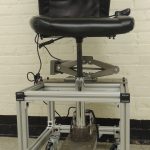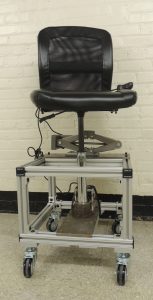Designers: Molly Quillin, Taylor Tew, and Fernanda Chow
INTRODUCTION
Samantha was diagnosed with Secondary-Progressive Multiple Sclerosis (SPMS) over 35 years ago. SPMS, a type of Multiple Sclerosis (MS), is a demyelinating disease of the Central Nervous System characterized by steady progression with little to no periods of recovery [1, 2]. Signs and symptoms vary widely depending on the amount of nerve damage, but patients diagnosed with a form of MS often lose the ability to walk independently [3]. In Samantha’s case, she uses a power wheelchair and has reduced arm strength, only allowing her to carry 2 kg. of weight with her arms outstretched. Unfortunately, her wheelchair is too large for her narrow, gallery-style kitchen so she currently uses a smaller stool. This stool lacks wheels, making it very exhausting for her to cook as she must stand up and drag the stool behind her whenever she needs to move.
There are many commercial products for increased mobility, but many of the products are reliant on the patient’s individual strength and balance. Furthermore, there are financial concerns present due to the chronic nature of MS and significant medical expenses. Rollators are a type of wheeled walker that can incorporate a reverse-locking mechanism to aid in stability. However, rollators require the use of both arms to be effective, and Samantha needs to be mobile and able to perform tasks in the kitchen [4]. Stools that incorporate wheels and locking mechanisms are quite common. However, there are safety concerns with wheels and their locking mechanisms due to Samantha’s diminished strength and gait difficulties [5, 6].
The goals of this project are to allow Samantha to move about the kitchen with both increased mobility and decreased exertion. The locking mechanism prevents chair movement as she sits herself and relies on the device for balance. Measures were also taken to extend the longevity of the device if Samantha’s core strength diminishes with time. The elevation mechanism allows Samantha to perform tasks at different heights throughout the kitchen. Furthermore, the base swivels so that she has to reposition less often. The improved design will allow Samantha to operate the device independently with a lowered physical effort and fewer safety concerns.
STATEMENT OF IMPACT
Kitchen Aid combines a small size, an elevation mechanism, and a docking station to ensure that our client can use her kitchen without fatiguing. This chair will have an impact on our client’s life, so that she will not only grow less tired when cooking but start to enjoy it far more. Additionally, her safety will greatly increase as she will no longer need to constantly stand up or bend over to access different appliances. Her decreasing fatigue and increasing safety will greatly impact our client’s quality of life as she will use the device to cook daily. As our client said herself, she is “very excited to prepare a meal in my new chair!”
TECHNICAL DESCRIPTION
Kitchen Aid encompasses several design features that accomplish the project goals of allowing Samantha to move around the kitchen safely with both increased mobility and decreased exertion. It is a custom chair composed of a mechanism that raises and lowers the chair height, and a docking station to ensure safety when getting in and out of the chair. It allows our client to more easily move around and access different parts of her kitchen in a safe and efficient manner. The lifting mechanism controls the device’s height from the base level of 22 in. to the maximum level of 31 in. with the use of a button (9 in. range). This allows our client to access all of her lower kitchen appliances, such as the freezer and dishwasher, while also accessing her higher cabinets. Turning the knob on the quick-release clamp onto the grab bar allows her to get in and out of her chair safely. While this docking station locks the chair in place, swivel casters allow for great mobility otherwise. Additionally, the chair’s base is 19’’x19’’ as compared to her previous stool that had a 16’’ diameter. The client’s kitchen is 5’x7’, making the completed device useful in the relatively small space.
- Lifting Mechanism
The lifting mechanism composed of a motorized scissor jack and pneumatic gas spring are used in combination to lift our client from the base height of 22’’ to 31’’. Due to the inherent unsteadiness of the scissor jack, a jack alone is not able to offer the stability necessary to lift our client in a safe manner. A pneumatic gas spring, however, offers great stability but relies on the user to stand up to lift it. As a result, both the motorized scissor jack and pneumatic gas spring are needed for our design. Because our client is unable to stand up and raise the gas spring, she uses the motorized scissor jack to provide the upward force and raise the seat. She simply needs to press the ‘up’ button on the jack and lift the handle on the air pump in order to raise herself nine inches.
- Docking Station
When entering and exiting the device, a docking station is utilized. This docking station is composed of a quick release clamp that is attached to the base structure, and a grab bar that is bracketed to our client’s wall. The client must simply back the device into the grab bar and turn the knob on the clamp to lock the chair in place and restrict movement.
- Base
The base is made from t-slotted aluminum structure. It has external dimensions of 19”x19”. Carbon-steel plates are used on the top for extra durability, and to offer a sturdy base of attachment for our chair. On the bottom, two crossbars support a steel plate that is welded to a steel support. This steel support has a tapered hole in which the gas spring of the device resides. Four polyurethane swivel casters allow for greater mobility. This base was chosen as the best option as it allows for the attachment of virtually any caster at set locations, is very durable, and allows minimum device elevation to be set.
REFERENCES
[1] C. Luzzio. (2015, Nov.16). Multiple Sclerosis [Online]. Available: http://emedicine.medscape.com/article/1146199-overview#a3
[2] C. M. Hersh. (2015, Nov.16). Multiple Sclerosis [Online]. Available:
http://www.clevelandclinicmeded.com/medicalpubs/diseasemanagement/neurology/mulple_sclerosis/
[3] M.J. Tullman, “Overview of the Epidemiology, Diagnosis, and Disease Progression Associated With Multiple Sclerosis,” in The American Journal of Managed Care, St. Louis, MI, 2013, pp.19
[4] (2015, Nov. 30). How to Choose the Mobility Device that is Right for You [Online]. Available: (http://www.nationalmssociety.org/NationalMSSociety/media/MSNationalFiles/Brochures/Brochure-How-to-Choose-the-Mobility-Device-that-is-Right-for-You.pdf
[5] A. T. Reder. (2011). Multiple Sclerosis [Online]. Available MedMerits: http://www.medmerits.com/index.php/article/multiple_sclerosis/P2
[6] J. L. Bainbridge, “Economics of Multiple Sclerosis and its Treatment,” Univ. of Tenn., Oct. 2007 [Online], Available: http://www.utasip.com/files/articlefiles/pdf/asip_4_11p330_333.pdf



University Operator: (919) 962-2211 | © 2024 The University of North Carolina at Chapel Hill |